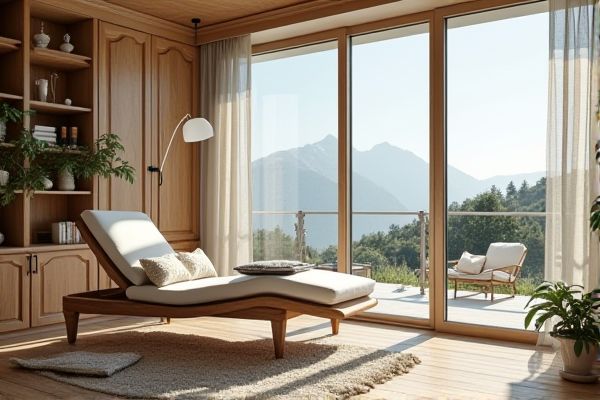
Loungers and sunbeds offer comfort for outdoor relaxation, but loungers typically feature adjustable backs and cushioned surfaces, enhancing your comfort for extended lounging. Explore the rest of the article to discover which option best suits your outdoor needs and lifestyle.
Table of Comparison
| Feature | Lounger | Sunbed |
|---|---|---|
| Purpose | Relaxing, reclining seating | Indoor tanning, UV exposure |
| Material | Wood, metal, plastic, fabric | Plastic, acrylic with UV lamps |
| Adjustability | Multiple reclining positions | Fixed design, usually horizontal |
| Location | Outdoor patios, poolside | Indoor tanning salons, home units |
| Comfort | Typically cushioned or padded | Hard surface, sometimes with gel pads |
| Functionality | Lounging, sunbathing | Tanning with UV light technology |
| Health considerations | Minimal risk, outdoor sun exposure | High UV exposure risk, skin damage potential |
| Price range | $50 - $500+ | $200 - $3,000+ |
Introduction: Lounger vs Sunbed
Loungers and sunbeds both provide comfortable outdoor seating designed for relaxation and sunbathing, but they differ in structure and functionality. Loungers typically feature adjustable backrests and cushioned surfaces, allowing customizable comfort, while sunbeds often emphasize durable materials suited for prolonged sun exposure. Choosing between a lounger and sunbed depends on individual preferences for comfort, portability, and aesthetic appeal in outdoor furniture.
Definition and Key Differences
A lounger is a piece of outdoor furniture designed for reclining and relaxation, typically featuring adjustable backrests and cushioned seating for enhanced comfort. A sunbed specifically refers to a type of lounger used primarily for sunbathing, often made with materials that withstand prolonged sun exposure. Your choice between a lounger and a sunbed depends on whether you prioritize versatile comfort or specialized sunbathing functionality.
Design and Structure Comparison
Loungers feature adjustable backrests and often come with cushioning for enhanced comfort, making them ideal for relaxation in various outdoor settings. Sunbeds typically have a more rigid structure with a flat surface designed primarily for sunbathing, often lacking the adjustable components found in loungers. Choosing between a lounger and a sunbed depends on your preference for ergonomic support versus a simple, minimalist design for tanning.
Material Choices: Durability and Comfort
Loungers typically feature durable materials such as aluminum frames combined with weather-resistant fabrics like textilene or woven wicker, offering comfort through ergonomic designs and breathable surfaces. Sunbeds often utilize sturdy plastic or metal bases with cushioned tops made from quick-drying foam or padded vinyl, prioritizing ease of maintenance and softness. Choosing between these options depends on desired durability in various weather conditions and the level of comfort preferred during extended outdoor relaxation.
Portability and Storage Options
Loungers often feature foldable frames made of lightweight materials like aluminum or plastic, enhancing portability for easy transport and storage. Sunbeds typically have a more rigid structure with limited foldability, which can make them bulkier and less convenient to move or store in compact spaces. Choosing between a lounger and a sunbed largely depends on whether portability and efficient storage are priorities for your outdoor or travel needs.
Adjustable Features and Ergonomics
Loungers offer multiple adjustable features such as reclining backrests, extendable footrests, and tiltable armrests to optimize comfort and support various seating positions. Sunbeds typically emphasize ergonomic design with contoured surfaces for even weight distribution and maximum relaxation while often providing less adjustability than loungers. The enhanced adjustability of loungers makes them ideal for personalized comfort, whereas sunbeds prioritize streamlined ergonomics for sunbathing efficiency.
Outdoor vs Indoor Usability
Loungers are designed for versatility, offering comfort and support suitable for both outdoor patios and indoor relaxation areas, often made with weather-resistant materials to withstand sun and rain. Sunbeds, primarily intended for outdoor use, feature UV-resistant coatings and adjustable reclining positions optimized for sunbathing by pools or beaches. Choosing between a lounger and a sunbed depends on intended placement and exposure to elements, with loungers providing more adaptable indoor-outdoor usability.
Maintenance and Cleaning Requirements
Loungers typically feature cushioned surfaces that require regular spot cleaning with mild soap and water to prevent stains and maintain fabric integrity, while sunbeds often have a durable plastic or metal frame that can be easily wiped down and sanitized. Avoiding harsh chemicals and using protective covers extend the lifespan of both loungers and sunbeds. You can simplify maintenance by selecting materials resistant to UV rays, moisture, and mildew to reduce cleaning frequency.
Price Range and Value Considerations
Loungers generally range between $150 and $600, offering adjustable features and ergonomic designs that enhance user comfort, making them a cost-effective choice for everyday outdoor relaxation. Sunbeds typically fall within a higher price range of $300 to $1,200, often incorporating UV protection technology and durable materials suited for tanning purposes, which justifies their premium cost. Value considerations hinge on usage needs, with loungers providing versatile support for leisure and sunbeds delivering specialized benefits for sunbathing enthusiasts.
Which Is Best for Your Needs?
Loungers offer adjustable backrests and cushioned comfort, ideal for relaxation and reading by the pool or patio, while sunbeds provide a flat, firm surface designed primarily for sunbathing and maximizing exposure to sunlight. Your choice depends on whether you prioritize ergonomic comfort for extended lounging or optimal sun exposure for tanning. Consider the material, portability, and space availability to determine which option best suits your outdoor lifestyle needs.
 homyna.com
homyna.com